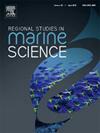Nutrient inputs from natural and anthropogenic sources to the Guapi-Macacu River Basin (Rio de Janeiro, Brazil): A region under the influence of peri-urban expansion processes
IF 2.1
4区 环境科学与生态学
Q3 ECOLOGY
引用次数: 0
Abstract
Increased anthropogenic nitrogen (N) and phosphorus (P) inputs to river basins are recognised as one of the main drivers of water quality deterioration. Identifying spatial patterns of N and P inputs is therefore crucial for appropriate management of river basins. This study investigated the spatial variation of natural and anthropogenic N and P inputs to the Guapi-Macacu River Basin (GMB) by integrating emission factor methodology with geoprocessing analysis. The N and P inputs from natural sources were 2170 and 10 kg km−2 yr−1, respectively. For anthropogenic sources, the N and P inputs were 1888 and 1009 kg km−2 yr−1, with livestock activity being the main contributor for both elements (53 % of N and 67 % of P). According to the geoprocessing analysis: (i) N input derived from biological fixation in the Atlantic Forest occur predominantly at steepest surfaces; (ii) livestock activity is distributed across flat and medium-slope surfaces; and (iii) inputs associated with agricultural and urban uses are concentrated in river plains. Despite the low relative importance of urban (35 and 21 % of anthropogenic N and P) and agricultural (12 and 11 % of anthropogenic N and P) inputs, spatial patterns suggest a high potential impact of these uses on water quality. Elevated N and P river flows in peri-urban areas, which are considerably higher than in rural areas, confirm this hypothesis. Mitigation strategies, such as the implementation of manure management and the construction of sewage treatment plants, are crucial to prevent water quality deterioration in the GMB.
自然和人为来源对瓜皮-澳门河流域(巴西里约热内卢)的养分输入:一个受城郊扩张过程影响的区域
河流流域人为氮(N)和磷(P)输入增加被认为是水质恶化的主要驱动因素之一。因此,确定氮和磷输入的空间格局对流域的适当管理至关重要。采用排放因子法和地理处理分析相结合的方法,研究了瓜皮-澳门河流域自然和人为氮、磷输入的空间变化特征。自然来源的N和P输入量分别为2170和10 kg km−2 yr−1。对于人为来源,氮和磷的输入量分别为1888和1009 kg km−2 yr−1,其中牲畜活动是这两种元素的主要贡献者(氮的53 %和磷的67 %)。根据地理处理分析:(i)大西洋森林生物固定产生的氮输入主要发生在最陡峭的地表;(ii)牲畜活动分布在平坦和中等坡度的表面;(三)与农业和城市用途有关的投入集中在河流平原。尽管城市(35%和21% %的人为氮和磷)和农业(12%和11% %的人为氮和磷)投入的相对重要性较低,但空间格局表明,这些用途对水质的潜在影响很大。城郊地区河流中氮磷含量的升高(远高于农村地区)证实了这一假设。实施粪便管理和建造污水处理厂等缓解战略对于防止小巴的水质恶化至关重要。
本文章由计算机程序翻译,如有差异,请以英文原文为准。
求助全文
约1分钟内获得全文
求助全文
来源期刊

Regional Studies in Marine Science
Agricultural and Biological Sciences-Ecology, Evolution, Behavior and Systematics
CiteScore
3.90
自引率
4.80%
发文量
336
审稿时长
69 days
期刊介绍:
REGIONAL STUDIES IN MARINE SCIENCE will publish scientifically sound papers on regional aspects of maritime and marine resources in estuaries, coastal zones, continental shelf, the seas and oceans.
 求助内容:
求助内容: 应助结果提醒方式:
应助结果提醒方式:


